How the discovery of a 1977 thesis led to a breakthrough at the Yamaha K’s Lab research division 30 years ago

The K’s Lab research group
You probably know that Yamaha is the world’s largest musical instrument manufacturer, but did you know that a vital pillar of the organization is a research group known as K’s Lab? K’s Lab, led by a research fellow, Dr. Toshifumi Kunimoto, has been researching physical modeling systems for more than 30 years, and is one of the most preeminent research groups in its field. K’s Lab was behind the development of the VL1 and VP1 musical instruments many years ago. More recently they were the driving force behind the RIVAGE PM10 professional live sound console, the THR series compact guitar amplifiers, and many more innovations.
K’s Lab recently moved from its former location in Toyooka to the new Yamaha Innovation Center on the grounds of the company’s headquarters in Hamamatsu. It was there that I had the opportunity to ask some of the group’s key members about their research and development activities. I will describe what I learned at this state-of-the-art and difficult to access research facility in three monthly installments. In this, the first installment, we’ll look back at how an unearthed thesis and a unique musical instrument led to the launch of K’s Lab.

K’s lab was established in 1987, 31 years before this article was written. The DX7 keyboard and its FM tone generator technology were a big hit at the time, and products using PCM tone generation were beginning to appear. Dr. Kunimoto remembers that his research began in response to orders from upper management to “create the next tone generation system within 5 years.”
K’s Lab started with Dr. Kunimoto at the helm and just 7 or 8 members. Not long after they had begun researching sound decay and other acoustic phenomena, they found an old thesis describing how the acoustic properties of a tapered tube could be simulated by using two straight-sided cylindrical tubes. That discovery triggered an avalanche.

“The thesis was well hidden, even though it was written by a prominent professor in the acoustics field, and it came as a revelation to us. For example, a saxophone has a tapered pipe so the calculations required to model its sound are extremely complex and involve large volumes of data. That made modeling impractical. But if we could simulate a tapered pipe with simple cylindrical pipes the situation would change entirely. Experiments to confirm the principle were begun immediately and,” as Dr. Kunimoto recalls, “we found that it was easy to simulate a saxophone sound both with a physical device and through modeling calculations.”

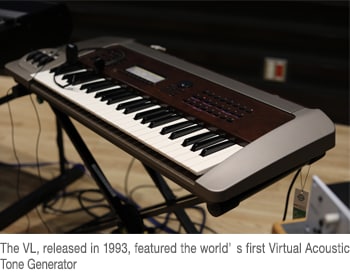
If thmpet or flute. It would basically apply to string instruments too, in which same mechanism of "wave delay" is shared with wave propagation in pipes, meaning that violins and guitars could be simulated with same kind of models. Research into computational modeling of natural musical instruments eventually led to the development of the VL1 in 1993. The VL1 implemented the world’s first “Virtual Acoustic Tone Generator” based on physical modeling.
K’s Lab had successfully carried out orders from above and created a revolutionary product within almost 5 years. But it was not destined to be a worldwide hit like the DX7.
Dr. Kunimoto explains: “It didn’t do very well in terms of business at the time, but the physical modeling concept had far greater implications. We were sure than it had enormous potential for the future, and particularly for electronic circuit simulation. On the surface it might seem that electronic circuit simulation is unrelated, but it is actually closely connected to wind and string instrument simulation on a technical level. We wanted to apply the technology to effects as well.”
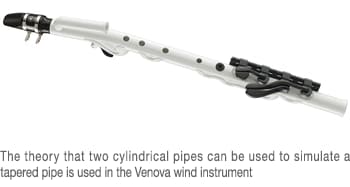
The VL1 included a number of effects, including flanger and distortion, that were in fact based on electronic circuit simulations created through physical modeling. Those effects marked the beginning of VCM (Virtual Circuitry Modeling) technology.
The theory that two cylindrical pipes can be used to simulate a tapered pipe was later applied in an entirely different way at Yamaha to create the innovative Venova “casual wind instrument” that was released and became a hit last year.
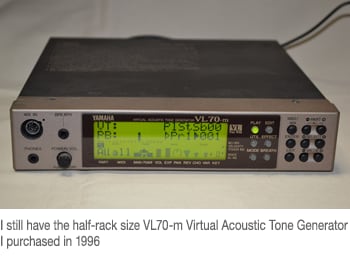
The VL1 was followed by the VP1 synthesizer in 1994. The VL7, a more economical version of the VL1, was released in the same year. Personally, I pounced on the half-rack size VL70-m when it was released in 1996, and I still have it in my possession. None of these products, however, were hugely successful in the business sense.
Dr. Kunimoto continues: “For a while in the latter half of the 1990s I became more involved in marketing and product development and was in a position to view the technology from and outside perspective. The remaining members of the technical team continued to work on products that employed physical modeling of analog circuitry, such as the AN1x and EX5 synthesizers.”
Dr. Kunimoto returned to the research group in 2001, marking the beginning of a refreshed wave of activity at a “new” K’s Lab. It was around this time that, at the request of the Yamaha pro audio division, the group began to focus on creating effects based on physical modeling of analog circuitry for digital mixing consoles.
Dr. Kunimoto remembers that “A large variety of plug-ins were already available in this area, some claiming to use physical modeling for analog circuit simulation. But when closely examined, it was clear that almost none were using modeling in its true sense. We began brainstorming among ourselves and developing true physical modeling effects that would be suitable for use in professional mixing consoles. Specifically, we were working on eight effects: studio compression and EQ, guitar stomp box effects, tape saturation, and others that could be added to our digital mixing consoles via a firmware update.”
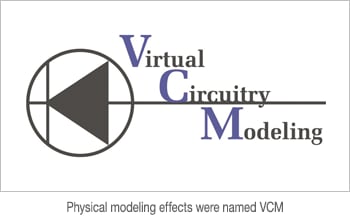
Physical modeling effects were introduced in the “V2” upgrades to the DM2000, 02R96, DM1000, and 01V96 digital mixing consoles for music production area released in 2002 and 2003, and immediately garnered industry-wide attention. It was at this time that the term VCM, for Virtual Circuitry Modeling, came into use and a K’s Lab logo was unveiled, launching the K’s Lab name into worldwide recognition.
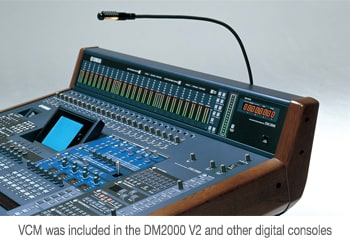
That first generation of VCM effects was also included in the subsequently released PM5D, M7CL, and LS9 live sound consoles, making VCM effects highly regarded assets in both the production and live sound fields. K’s Lab was already working on new VCM effects, and the second generation was introduced with the CL series digital mixing consoles that made an impact on the industry with built-in Dante support when released in 2012.
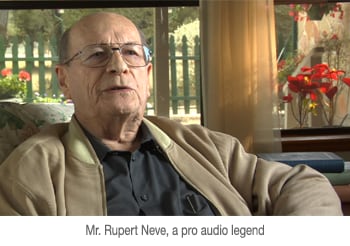
According to Dr. Kunimoto, one of the highlights of the time was Yamaha’s collaboration with Rupert Neve Designs (RND). RND is led by Mr. Rupert Neve, a legendary engineer who is in many ways responsible for building the foundations of today’s pro audio industry.
Regarding the RND collaboration, Dr. Kunimoto recalls: “One surefire approach is to create emulations of famous analog devices, but it has to be something that nobody else has done. It needs to be emulations, preferably of well-known equipment, that no other vendor has yet succeeded in producing. Our PA division suggested the Portico series of analog outboard devices produced by RND. I personally didn’t even think of the possibility of working with such an industry legend, but was confident that we had done the necessary research and would be able to thoroughly and accurately model those devices.”
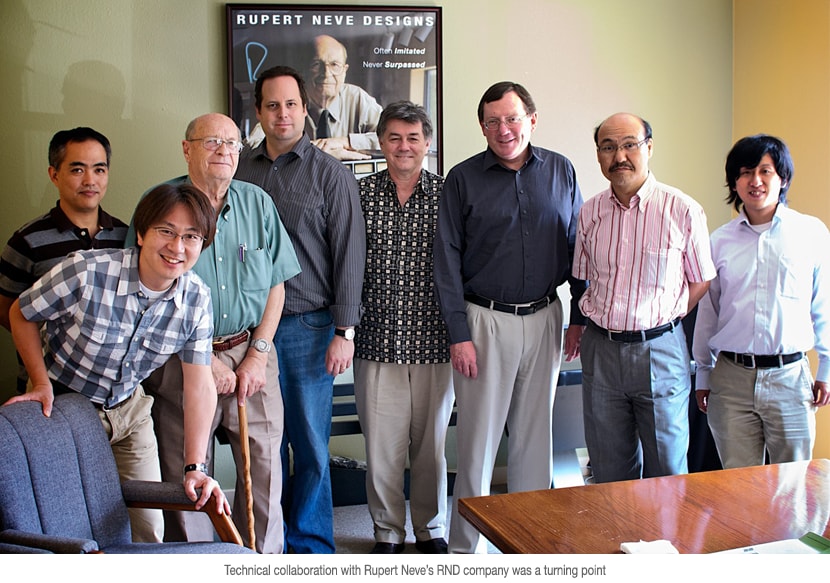

In September of 2007, 5 years before the release of the CL series, a meeting was arranged with Mr. Rupert Neve. Nervous and having no idea how he would react, the VCM sound developed by K’s Lab was presented to Mr. Neve for his appraisal. Mr. Neve’s response was “the musicality is good, and the characteristics of the actual device are audible.” Dr. Kunimoto notes that “Before meeting Mr. Neve we had been experimenting with modeling Neve products, SSL consoles, and other vintage equipment, and were already familiar with their essence. That is probably part of the reason we were able to satisfy Mr. Neve.” Rupert Neve then proceeded to describe his audio design philosophy in depth. A shared technological background led to immediate understanding and acceptance between the two engineers.

After months of development, the first Portico model was auditioned by Mr. Neve. His response, “it is very close,” indicated that he was not 100% satisfied. Mr. Neve continued to provide advice about how the high end could be adjusted or how the low-end harmonics should be tweaked to match his own device until an ideal model had been achieved. Dr. Kunimoto notes that “In the end he was 100% satisfied.”
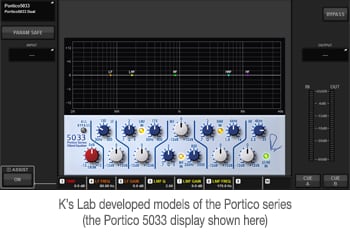
While we’re on the subject, how does physical modeling of analog circuitry work? Is it actually possible to simulate all circuits with just one capacitor and one transistor?
If it were possible to reproduce a circuit’s characteristics and sound exactly through basic digital computation, that would be all that is necessary. But when you consider the subtle behavior of analog circuitry it is rarely that simple. In such cases it is necessary to precisely simulate the characteristics of basic circuitry consisting of one capacitor, one transistor and so on. Looking at the whole system, simple processing is applied to sections that can be reproduced easily, while deeper simulation is applied to sections than need more detail. The key is to apply those two approaches appropriately. In this way, VCM precisely recreates the characteristics and sound of the original analog equipment.
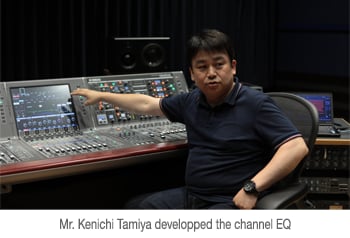
Now let’s take a closer look at an actual K’s Lab product. We’ll examine a channel equalizer with characteristics that are relatively easy to understand. Channel EQ, sometimes called channel strip EQ, refers to the equalization provided on each channel of a mixing console for individual channel adjustment. Although it is not exactly an “effect,” we’ll look at the channel EQ provided on current Yamaha mixing consoles such as the RIVAGE PM and CL/QL series.
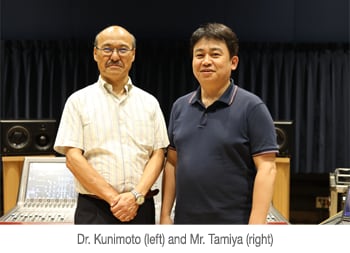
Mr. Kenichi Tamiya is an EQ technology specialist and was responsible for developing the channel EQ software. Mr. Tamiya became preoccupied with audio during his college years, and joined Yamaha to fulfil his dream of developing AV amplifiers. He became a K’s Lab member in 2010 after spending time developing sound field data for AV amps, and speakers for commercial applications. He was assigned to K’s Lab right around the time that Dr. Kunimoto was the general manager of the Yamaha Research & Development Center.
Mr. Tamiya: “The basic design of the channel EQ included in the Yamaha PM1D, released in 2001, was carried over in subsequent models up until the RIVAGE PM10 system that was introduced in 2015. The RIVAGE PM10 features a new channel EQ that had been in development since around 2012. Designing the new channel EQ was a huge responsibility, because it would become the Yamaha standard for years to come. In addition to being musical, the new equalizer had to be easy to use and allow quick adjustment for any musical instrument and type of music. Our job was to create a channel EQ that satisfied all of those criteria.”
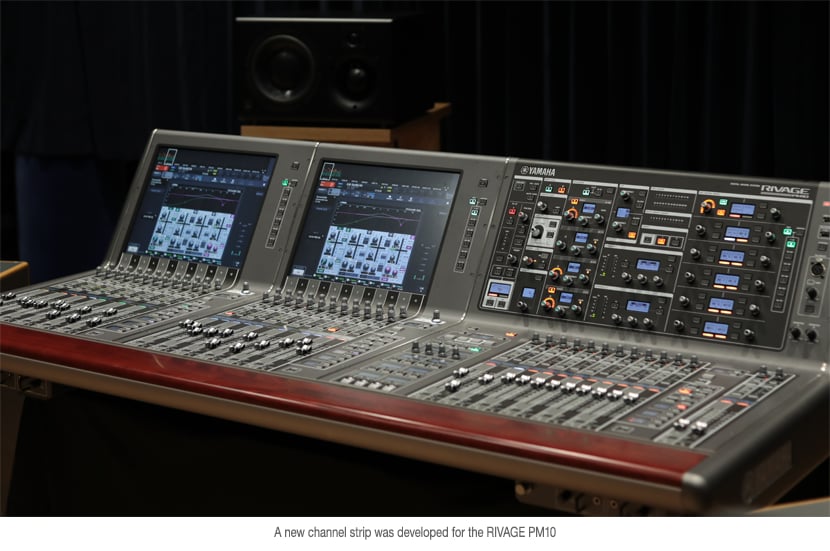

That sounds like a difficult challenge. Mr. Tamiya responded by creating three channel EQ variations that users could select as necessary.
According to Mr. Tamiya, “The equalizer that has been included in consoles and processors since the PM1D has been retained as the “Legacy” EQ, while three new algorithms have been added: Precise, Aggressive, and Smooth. The difference is clear when you see the EQ response curves.”
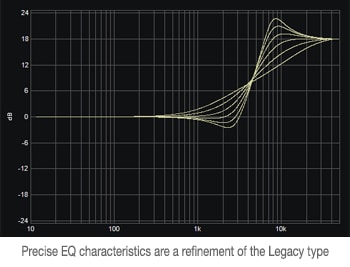
Looking at the EQ types in order, the response of the Legacy type is mathematically accurate. The Precise type retains the accuracy of the Legacy EQ while allowing EQ points to be precisely set and adjusted for a wide range of tonal control. Looking at the response you can see a small amount of overshoot (a slight rise before roll off), which makes the effect of adjustments easy to hear. The Precise type has also been carefully designed so that the control frequency remains subjectively constant when the EQ gain is changed, and the overshoot rise and zero-cross frequency are linked to EQ gain so that no unnecessary frequencies are affected by EQ adjustments.
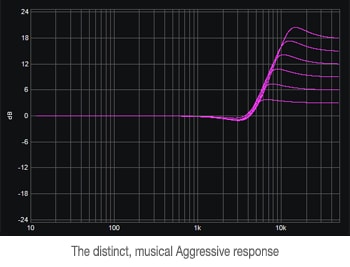
The Aggressive type, on the other hand, is extremely musical while producing distinct changes. Overshoot on shelving curves is somewhat emphasized so that adjustments are clear and musical. Peaking curves have relatively strong proportional Q so that small changes in EQ gain produce a noticeable and pleasing effect.
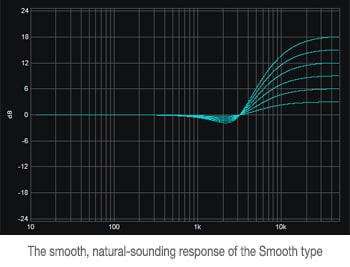
As the name implies, the Smooth type allows smooth, natural sounding adjustments that won’t obscure the essential characteristics of the source. Like the Legacy type there is no overshoot on shelving curves, but the zero-cross frequency of the rise is kept constant so that operational ease is retained while allowing smooth, natural sounding response shaping.
I would recommend auditioning all four types if you get the chance. The difference is quite clear. The amount of versatility available in just one channel equalizer is amazing.
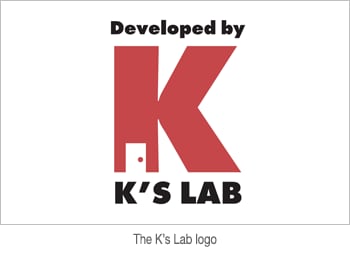
With 30 years of history as a foundation, K’s Lab delivers some of the most advanced physical modeling based sound tools. In the next installment we’ll go into more detail.






